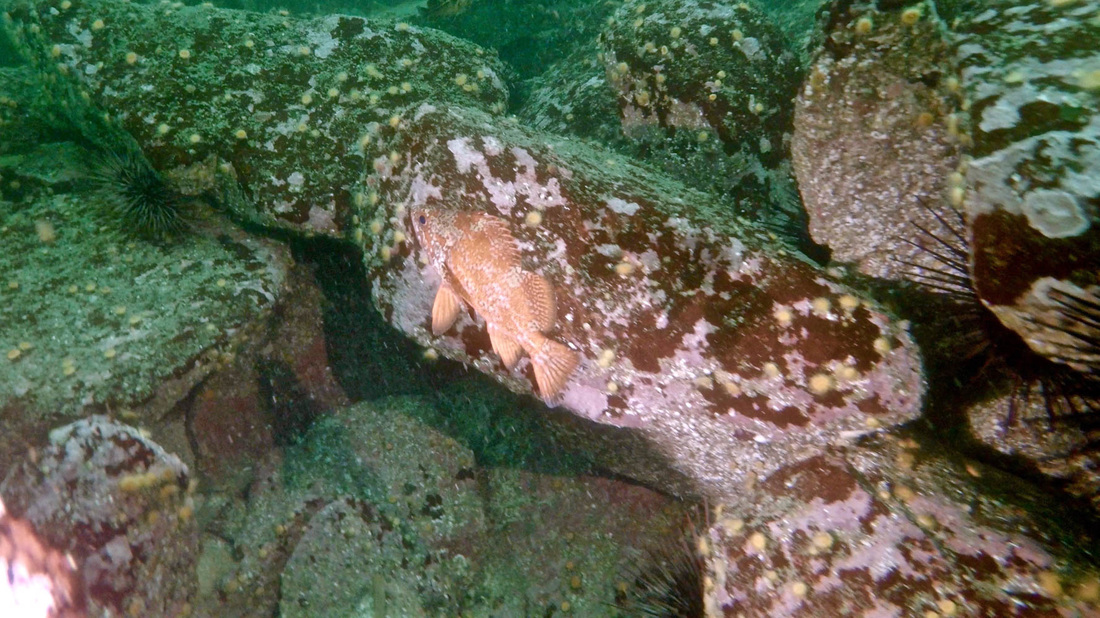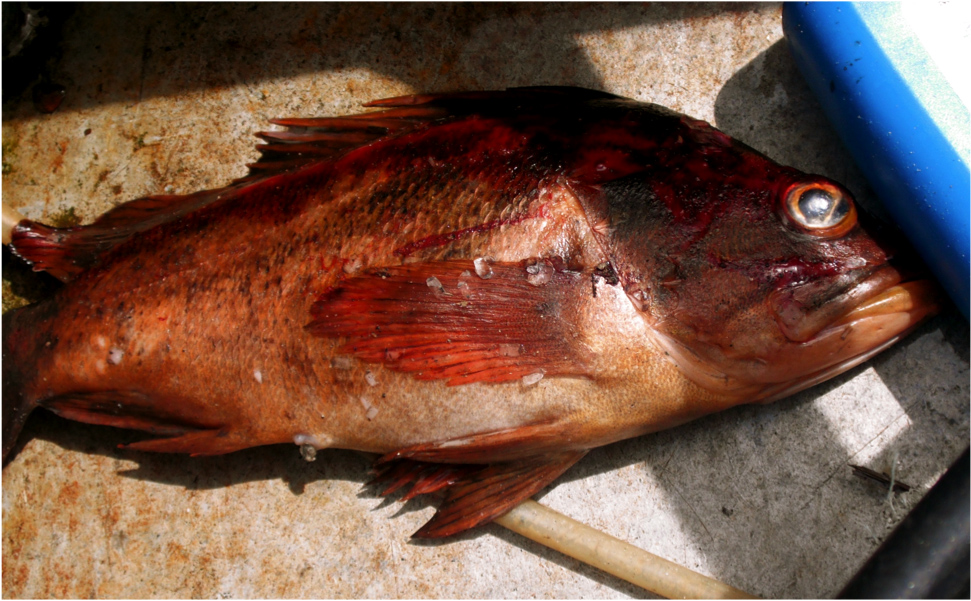Vermilion rockfish • Sebastes miniatus • Heiltsuk/Haíɫzaqv - λák̓álá
Identification
The vermilion rockfish is a vibrant red fish with mottled grey sides, a red mouth and fins, and a whitish or lighter area along part of the lateral line. Some other identifying features include rounded pelvic and anal fins; a rough, scaly lower jaw; and, often but not always, black edging along its fins. Juveniles are a duller brown colour. The maximum recorded length of this species is 91 cm.
Habitat & Range
This rockfish forms small schools and can be found around rocky reefs from as shallow as 6 m to over 250 m deep, though they are less common in deeper locations. Individuals may be found among schools of canary rockfish. Juveniles may be found closer to the bottom in shallow locations, often hiding among kelp or in rock crevices. Its range extends from central Alaska to northern Mexico.
Similar Species
The vermilion rockfish can be confused with the canary rockfish (Sebastes pinniger), especially under water where its red colouring can appear more brownish or yellowish. The canary rockfish has more pointed anal and pelvic fins, and tends to be a less vibrant colour. Another similar species, the yelloweye rockfish (Sebastes ruberrimus), lacks the grey mottling of the vermlion rockfish.
Human Uses
The vermilion rockfish is commonly caught with other rockfish in California, but is only occasionally caught in more northern fisheries. It is often mistakenly labelled in fish markets as red snapper due to its bright red colour.
Intriguing Info
The sunset rockfish (Sebastes crocotulus) was split from the vermilion rockfish in 2008. It is currently only known at depths below 100 m, from central California to northern Mexico.
iNaturalist
https://www.inaturalist.org/taxa/64474-Sebastes-miniatus
The vermilion rockfish is a vibrant red fish with mottled grey sides, a red mouth and fins, and a whitish or lighter area along part of the lateral line. Some other identifying features include rounded pelvic and anal fins; a rough, scaly lower jaw; and, often but not always, black edging along its fins. Juveniles are a duller brown colour. The maximum recorded length of this species is 91 cm.
Habitat & Range
This rockfish forms small schools and can be found around rocky reefs from as shallow as 6 m to over 250 m deep, though they are less common in deeper locations. Individuals may be found among schools of canary rockfish. Juveniles may be found closer to the bottom in shallow locations, often hiding among kelp or in rock crevices. Its range extends from central Alaska to northern Mexico.
Similar Species
The vermilion rockfish can be confused with the canary rockfish (Sebastes pinniger), especially under water where its red colouring can appear more brownish or yellowish. The canary rockfish has more pointed anal and pelvic fins, and tends to be a less vibrant colour. Another similar species, the yelloweye rockfish (Sebastes ruberrimus), lacks the grey mottling of the vermlion rockfish.
Human Uses
The vermilion rockfish is commonly caught with other rockfish in California, but is only occasionally caught in more northern fisheries. It is often mistakenly labelled in fish markets as red snapper due to its bright red colour.
Intriguing Info
The sunset rockfish (Sebastes crocotulus) was split from the vermilion rockfish in 2008. It is currently only known at depths below 100 m, from central California to northern Mexico.
iNaturalist
https://www.inaturalist.org/taxa/64474-Sebastes-miniatus
References
Froese, R. and Luna, S. M. Sebastes miniatus (Jordan & Gilbert, 1880) Vermilion rockfish. FishBase. Accessed 09/11/2015.
Lamb, A. and Edgell, P. Coastal Fishes of the Pacific Northwest. Revised. (2010). Madeira Park, BC: Harbour Publishing. P.
Lamb, A., and Hanby, B. (2005). Marine Life of the Pacific Northwest [electronic version]. Madeira Park, BC: Harbour Publishing.
Vermilion rockfish Sebastes miniatus. Fishing & Shellfishing. Washington Department of Fish & Wildlife. Accessed 09/11/2015.
Authors and editors of page
Kelly Fretwell (2015).
Froese, R. and Luna, S. M. Sebastes miniatus (Jordan & Gilbert, 1880) Vermilion rockfish. FishBase. Accessed 09/11/2015.
Lamb, A. and Edgell, P. Coastal Fishes of the Pacific Northwest. Revised. (2010). Madeira Park, BC: Harbour Publishing. P.
Lamb, A., and Hanby, B. (2005). Marine Life of the Pacific Northwest [electronic version]. Madeira Park, BC: Harbour Publishing.
Vermilion rockfish Sebastes miniatus. Fishing & Shellfishing. Washington Department of Fish & Wildlife. Accessed 09/11/2015.
Authors and editors of page
Kelly Fretwell (2015).






